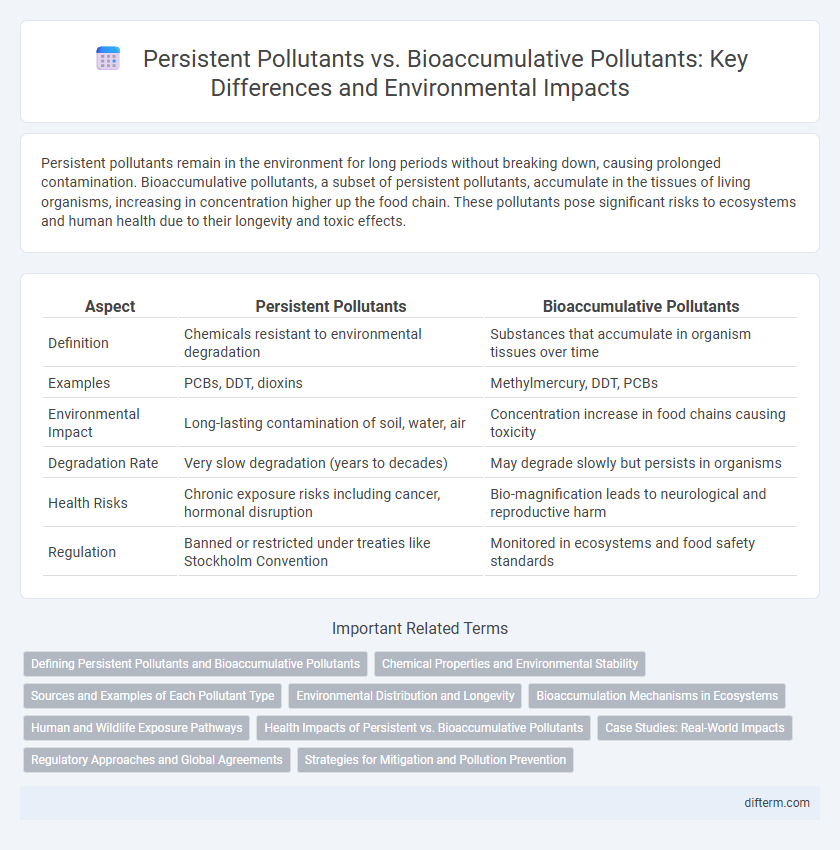Persistent pollutants remain in the environment for long periods without breaking down, causing prolonged contamination. Bioaccumulative pollutants, a subset of persistent pollutants, accumulate in the tissues of living organisms, increasing in concentration higher up the food chain. These pollutants pose significant risks to ecosystems and human health due to their longevity and toxic effects.
Table of Comparison
| Aspect | Persistent Pollutants | Bioaccumulative Pollutants |
|---|---|---|
| Definition | Chemicals resistant to environmental degradation | Substances that accumulate in organism tissues over time |
| Examples | PCBs, DDT, dioxins | Methylmercury, DDT, PCBs |
| Environmental Impact | Long-lasting contamination of soil, water, air | Concentration increase in food chains causing toxicity |
| Degradation Rate | Very slow degradation (years to decades) | May degrade slowly but persists in organisms |
| Health Risks | Chronic exposure risks including cancer, hormonal disruption | Bio-magnification leads to neurological and reproductive harm |
| Regulation | Banned or restricted under treaties like Stockholm Convention | Monitored in ecosystems and food safety standards |
Defining Persistent Pollutants and Bioaccumulative Pollutants
Persistent pollutants are chemical substances that resist environmental degradation through chemical, biological, and photolytic processes, remaining in the ecosystem for extended periods. Bioaccumulative pollutants are contaminants that build up in the tissues of living organisms at concentrations higher than those in the environment, often increasing in concentration up the food chain. Both types of pollutants pose significant risks to ecological and human health due to their longevity and potential to magnify toxic effects.
Chemical Properties and Environmental Stability
Persistent pollutants exhibit strong chemical stability, resisting degradation through processes like photolysis, hydrolysis, and microbial metabolism, which ensures their long-term presence in the environment. Bioaccumulative pollutants possess lipophilic properties that enable them to concentrate in the fatty tissues of organisms, magnifying through food chains and posing significant ecological risks. Both types of pollutants challenge remediation efforts due to their chemical inertness and environmental persistence, leading to prolonged contamination and bioavailability.
Sources and Examples of Each Pollutant Type
Persistent pollutants originate from industrial processes, agriculture, and waste disposal, with examples including polychlorinated biphenyls (PCBs) and dioxins, known for their long-term environmental persistence. Bioaccumulative pollutants, such as mercury and certain pesticides like DDT, accumulate in living organisms through the food chain, often originating from mining, fossil fuel combustion, and agricultural runoff. Both pollutant types pose significant ecological and health risks due to their stability and ability to concentrate in wildlife and humans.
Environmental Distribution and Longevity
Persistent pollutants remain stable in the environment for decades, resisting degradation through chemical, biological, or photolytic processes, which enables widespread distribution across air, water, and soil. Bioaccumulative pollutants concentrate within living organisms over time, magnifying through food chains and causing toxic effects even at low environmental concentrations. The combined longevity and environmental distribution of these pollutants exacerbate ecosystem contamination and pose long-term risks to biodiversity and human health.
Bioaccumulation Mechanisms in Ecosystems
Bioaccumulative pollutants accumulate in living organisms through processes such as absorption, ingestion, and biomagnification, concentrating in tissues over time. These pollutants, often lipophilic substances like PCBs and mercury, persist in ecosystems by moving up the food chain, resulting in higher toxicity at apex predators. Persistent pollutants remain chemically stable, but bioaccumulation intensifies ecosystem exposure and disrupts biological functions.
Human and Wildlife Exposure Pathways
Persistent pollutants such as polychlorinated biphenyls (PCBs) and dioxins remain in the environment for decades, posing long-term exposure risks to humans and wildlife primarily through ingestion of contaminated food and water. Bioaccumulative pollutants like mercury and certain pesticides concentrate in organisms' tissues, leading to higher exposure levels up the food chain, affecting top predators and human populations reliant on fish and game. Understanding these exposure pathways is critical for assessing health risks and implementing effective environmental regulations to protect ecosystems and public health.
Health Impacts of Persistent vs. Bioaccumulative Pollutants
Persistent pollutants remain in the environment for extended periods, posing long-term health risks such as cancer, respiratory issues, and endocrine disruption. Bioaccumulative pollutants concentrate in living organisms over time, leading to higher internal doses that can cause neurological damage, reproductive disorders, and immune system impairment. Exposure to both types increases the risk of chronic diseases and can have transgenerational effects, impacting human populations and wildlife health globally.
Case Studies: Real-World Impacts
Persistent pollutants such as polychlorinated biphenyls (PCBs) have caused long-lasting environmental contamination in the Hudson River, leading to severe impacts on aquatic life and human health. Bioaccumulative pollutants like mercury in the Minamata Bay case illustrate how toxins concentrate through the food chain, resulting in devastating neurological disorders in local communities. These case studies demonstrate the critical need for targeted remediation and stricter regulation to mitigate the long-term risks of environmental pollutants.
Regulatory Approaches and Global Agreements
Regulatory approaches to persistent pollutants prioritize strict controls under frameworks like the Stockholm Convention, which targets Persistent Organic Pollutants (POPs) due to their longevity and environmental persistence. Bioaccumulative pollutants face regulation through measures aimed at limiting their entry into food chains, emphasizing monitoring and risk assessments under agreements such as the Minamata Convention for mercury. Global agreements coordinate international efforts for phasing out hazardous substances, enforcing reporting obligations, and promoting safer alternatives to mitigate ecological and human health risks.
Strategies for Mitigation and Pollution Prevention
Strategies for mitigating persistent and bioaccumulative pollutants emphasize source reduction through stringent regulations on hazardous chemical use and disposal. Implementing advanced waste treatment technologies and promoting eco-friendly alternatives minimize environmental release and bioaccumulation in food chains. Continuous monitoring and public awareness campaigns support early detection and prevention of pollutant persistence in ecosystems.
persistent pollutants vs bioaccumulative pollutants Infographic

 difterm.com
difterm.com